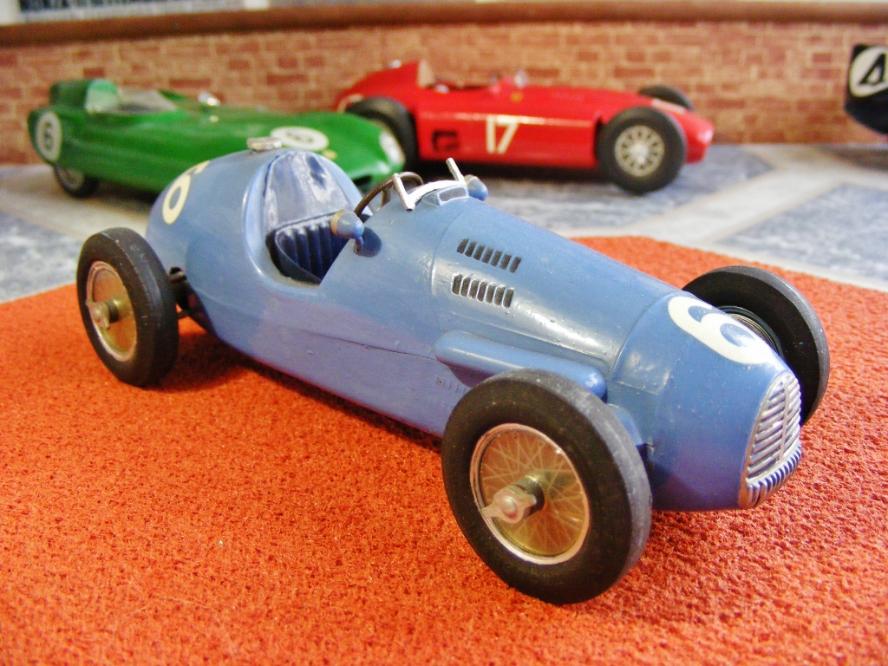
Gordini Type16 racing car.
One of the strangest things about the post World War Two racing scene was that while France held the first recognised post war motor race, and had many talented drivers to put forward, the French motor industry all but turned it's back on the sport.
Support for the motor racing industry was severely hit by the war, but in Italy they were ready for racing. Having apparently not taken the war too seriously Alfa Romeo and Maserati were putting new cars together while it took privateers to race largely pre-war Delage, Bugatti, or Delahaye motors in representation of France.
The one tiny French firm that stayed in the fight was that of Amedée Gordini. Today the Gordini name is a known as part of Renault Sport Technologies and used for racing and the higher performance road car models, but back in 1946 Amedée Gordini was a renown tuner of high performance engines and racing sports car manufacturer.
Amédée Gordini emigrated from Italy to Paris in the 1930s. Starting to construct Fiat based racing engines and cars through Simca having the licence to build Fiat cars in France. His wizardry in engine tuning garnered him the nickname "le sorcier de la mécanique", or simply, "Le Sorcier", the Sorcerer in English. His abilities were so well known that he was often approached by individuals for assistance in tuning engines and chassis. Simca themselves hired him to develop road cars.
Post war Gordini returned to his racing ambitions with Simca-based sports cars, and was even able to persuade Simca to build his enhanced engine designs.
Unfortunately, while Gordini valiantly continued to manage his little team, with some support from Simca, his budget was always meagre at best. Nevertheless, Gordini's little cars accrued some quite impressive results across F2, sports car and some of the smaller F1 races. His sports cars even made some appearances in many of the European long-distance races.
However, the 1.5-litre, supercharged four-cylinder engine of the Type 15, in its small, rounded chassis, was being tuned beyond the point it could contain itself. While the nimble little car was able to compete on the tight, low-speed circuits where its handling was an advantage, at the high speed circuits the T15 was at a serious disadvantage.
Attaining 4th place at the Belgian GP in 1950, Amedée Gordini was squeezing every ounce of power out of his engines. Stretching his equipment and money as far as he could. But 1951 would see little more than a string of engine failures. The result being Simca's withdrawal of support.
Just as things seemed to be coming to an end for Gordini, Alfa Romeo announced it was withdrawing from GP racing leaving Ferrari, and its 4.5-litre V12 type 375, clear to dominate the sport of F1. This forced the sport's governing body to change the world drivers championship from F1 to F2, and adjust the F2 technical rules, most importantly insisting on only allowing normally aspirated 2litre engines. While designing a new engine and chassis in a short period would be a challenge to Amedée Gordini, it was also a life-line for his little firm.
Design
Gordini managed to scrape together the cash to create his new monoposto car for the 1952, and 1953, seasons. Presenting the world with the 1952 Gordini T16.
A cursory look at the Gordini Type 16 suggests it is much the same as the the Simca Gordini Type 15; but that is just an illusion. While it was similar in size and shape, so shared the nimble driving characteristics, it was reasonable amount lighter. While the short wheelbase allowed drivers to slide the car successfully, the tall, narrow body lines led to a slightly unstable feel in corners. While other manufacturers were looking to widen and lower their cars in order to reduce the centre of gravity, the T16 seems oddly vertical in design.
The plus was that overall it was a clean car with very little but the wheels and suspension arms exposed in the airflow.
Bodywork and chassis
The T16;s arched shaped body styling and louvred hood looked much as the T15 had minus the air duct required for the 4-cyl engines supercharger intake. A blunt nose housed the radiators through a slat grilled opening which was often in need of widening and/or the complete removal of the grill face.
One of the most obvious facets of the narrow body are the deep cut out cockpit sides. Something which, coupled to the high centre of gravity, meant many drivers felt somewhat exposed in tight corners and led to several bracing techniques being adopted by the different drivers; there being no seat belts or roll bars in the regulations back then.
The cockpit itself was sparse with just a few instruments in a small panel and a large, dominating, steering wheel. Behind the steering wheel was the gear shift lever connected to the four-speed gearbox. A small aero-screen sat atop the body, for driver protection, with a small round mirror on either side.
Directly behind the driver in the tapering tail section was the fuel tank. There was little in the way of separation bar the back of the seat. The filler tube and cap protruding up through the centre spine of the tail section.
The pale French blue panels covered a new tubular ladder-type chassis which proudly supported brand new type 20 engine. The new straight six-cylinder Gordini engine had a displacement of 1987cc (well within the 2ltr cap), from ‘square’ cylinder dimensions of 75x75mm bore and stroke. This all alloy engine had cast iron wet liners, seven main bearings and twin overhead camshafts, driven by a train of gears, to operate the valves via rockers. The three initial Solex twin-choke 38 carbs were soon superseded by three Weber 38DCO3 which, alongside Scintilla Vertex magneto ignition gave a claimed 175bhp output. History would suggest this was an exaggeration, and in any case was still much less than Ferrari's new 500 was producing. A later suggestion of 157-bhp @ 6500rpm would seem much more realistic. Power went through an in unit four-speed transmission. The rigid rear axle proved to be a source of constant retirements through 1952 but was eventually made more pliable. Front suspension was independent, in both cases suspension was through torsion bars. Four wheel hydraulic drum braking finished off the package.
Car-Race-Driver
The Gordini T16 might have been under powered compared to the Alfa Romeos and Ferraris it fought against, but it was compact and agile, nimble on the twisting circuits were it could compete more evenly with the opposition.
Most of the success of the T16 came in the hands of divers who could extract the maximum from the cars handling without overstressing the engine. Men like Jean-Pierre Wimille had shown the way in the T15 but he had perished in an accident in 1948.
Equipe Gordini works drivers were named as Maurice Trintignant, Robert Manzon and Jean Behra. Although he was the youngest of three Behra proved to be a master of the T16 and drove for the team from 1951 till 1954. He would go on to drive for Maserati, Ferrari, BRM and Porsche, across F1 and sports car racing.
Behra and the T16 would become synonymous. Although he didn't get an F1 victory he did win non-championship races. And he did appear on the podium for Gordini in the 1952 Swiss GP, behind the Ferrari 500s of Taruffi and Fischer. Manzon equalled the result at the next race finishing 3rd in Belgium. These would be the best top flight results for Gordini.
In non championship races Behra won the:
IV Circuit du Lac at the Aix-les-Bains Circuit du Lac 8 June 1952
20th Grand Prix de la Marne at Reims-Gueux 29 June 1952
1954 Pau Grand Prix non-championship F1 race 19 April 1954
6th Circuit de Cadours non-championship F1 race 12 September 1954
Andre Pilette won Coupes de Paris 17 April 1955
Overall this isn't a bad record for a tiny underfunded team like Gordini. Several minor placings were also attained but when no context is included the T16's history is one of engine failures and mechanical breakdowns. That is arguably an unfair assessment against such mighty opposition as Maserati and Ferrari.
Conclusion
Quintessentially French, elegant, petite and nimble, the little Gordini GP cars have a special place in the history of motor racing. Like Coopers 500 cars many up and coming drivers drove Gordini's little, unlike Cooper they never broke into the big time.
As the old T16 cars became outclassed a new 2.5ltr engine was built for the new F1 regulations, but that proved to be too heavy for the little car and breakdowns occurred often.
Gordini built a new car for 1955, the 8-cyl engined T32. It too, was too heavy to be competitive. The old T16s were were sold off to private drivers but the finances were fast becoming exhausted. No one in the French motor manufacturing came forward to support Amedée Gordini's efforts. By the middle of 1957 Gordini's dream was over. The time of the independent team owner was yet to come.
Amedée Gordini's team made their last appearance at the 1957 le Mans, neither car finished. Thereafter, Amedée became a consultant engineer. His skills were so highly prized that this may have been the reason no-one came forward to support his team. He himself was the most valuable asset. Renault won the race for Gordini's signature and he set to work.
Amedée worked in Renault's development department. One of his earliest jobs was creating a sporty Dauphine saloon, suitably entitled, the Dauphine-Gordini. The sporty car proved to be a great seller. Gordini tuned other Renault cars for rallying and Renault-Sport winning a number of rallies through the 1950s and 1960s. Renault-Gordini cars also took part in the Le Mans 24hrs between 1962-69. Amedée Gordini also played a big part in creating and developing the Renault brand of Alpine, now a renowned tuning brand and making a link for Gordini in modern F1. Gordini's work was so prolific by 1968 'Gordini' became a division of Renault.
In 1976 the Gordini name became a part of Renault-Sport, Gordini's technicians had a big role in the development of Renault's 1.5ltr, 6-cyl, V6, F1 turbo charged engine in the 1970s. His name proudly emblazoned on the cam-covers when the Renault RS01 made its debut in the 1977 British F1 GP.
Sadly for Jean-Pierre Jabouille the #15 RS01's engine expired on the 17th lap; all rather reminiscent of Gordini's GP adventures of the 1950's. It took a while to turn the Renault Turbocharged engine car into a reliable package, but their pioneering work would soon lead to all the whole grid being turbo powered.
The Gordini cars, and Amedée Gordini's name, still hold a place in the heart of racing car enthusiasts, especially in France. His contribution the motor sport and
Renault's sporting ambitions cannot be under estimated. So much so, Renault continue to use the Gordini name for many of it's sporty models to this day.
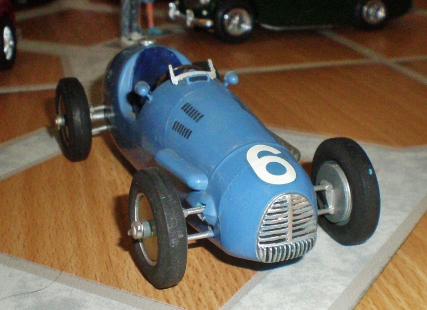
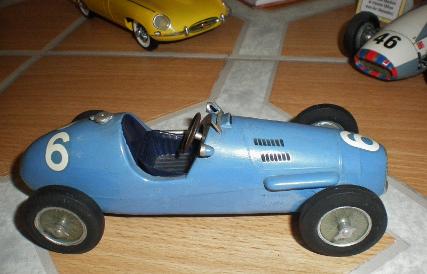
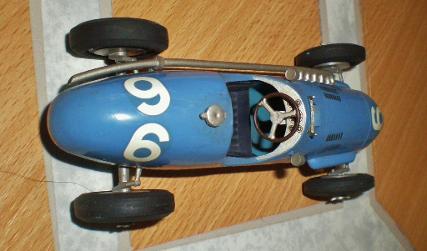
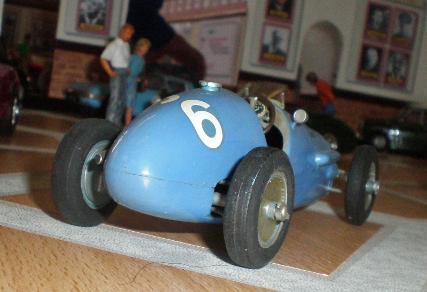

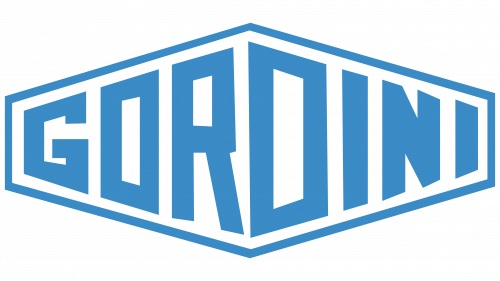
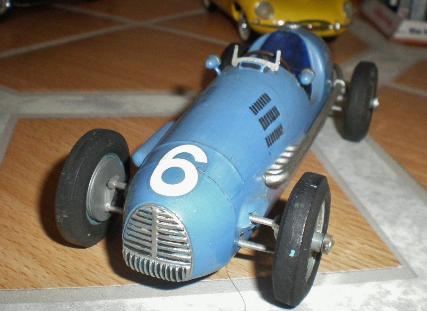
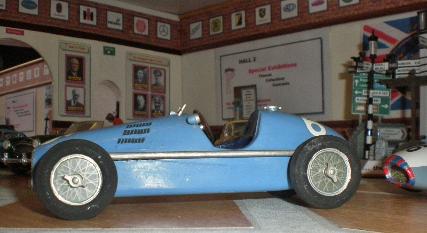
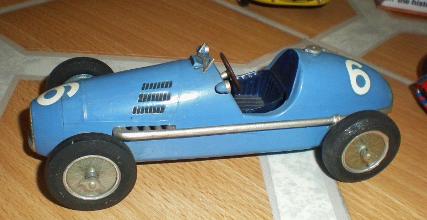
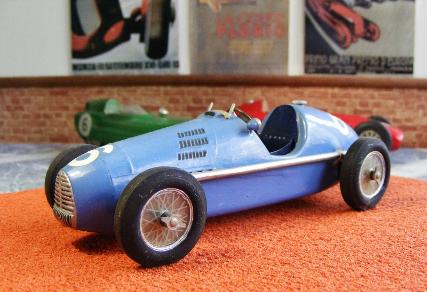
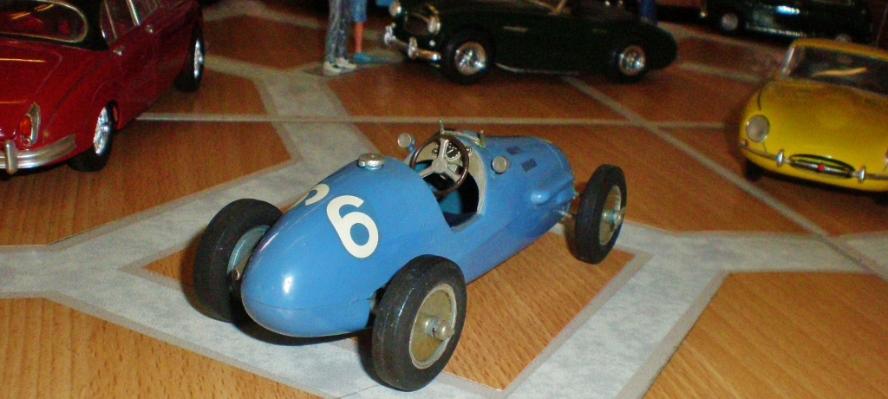
Merit 1/24th scale kit, #4638.
Merit is an oft' forgotten manufacturer today but between 1956 and into the very early 1970s the firm produced many wonderful static kits of cars, ships and aircraft. They also had a good range of model railway model kits too. When the firm close its doors the moulds went all over the world being rebadged by other firms, the whereabouts of many are now not known.
The Merit range of 14 racing car kits, covers the late 1940s to the late 1950s. Today they are much revered by lovers of that era of racing who build, race or collect them. No kit manufacturer of cars of that era has ever captured the body shapes as well as Merit did. It is a testament to the quality of the body shapes that many of the range have been moulded, cast in resin, and released with additional parts and details. Further more those 're-pops' (by more than one seller), have always sold well too.
The prices for original kits on auction sites range from £30 to £80 and not always because the kits are mint either. This tells us there are bargains to be had for the building if you are patient and keep your eyes open.
Also keep your eyes on slot car sites. Merit kits have always been popular with the Slot-car community due to bing easy to adapt as slot car bodies; so they show up there too. If you are keen to build one then keep your eyes open for a built model. They can be stripped down, upgraded and turned into super little models for very little money. Ian has done it several times!
Our model is a genuine modelling time piece, being built in the kit production era with the tools and accessories of the 1950s. It was built by Rod and ranks amongst his earliest models. It is brush painted with Humbrol enamel paints and still has it's original transfers (as we used to call them), in situ. Ian also has a couple of these kits in his stash too. Perhaps one day he will do us a favour and build one with the benefit of all that the modern world has to offer. Wouldn't that give us a nice contrast of the two modelling eras.
RETURN TO:-
